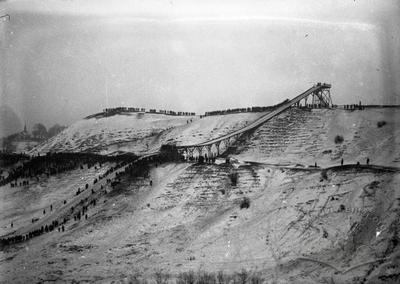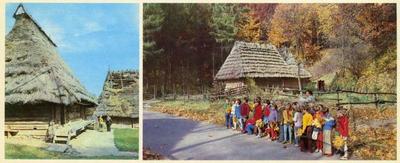Vul. Staroznesenska – Znesinnia Park ID: 2006
Znesinnia Park is a regional landscape forest park located in northeastern Lviv. It was established in 1993 for the preservation of the singular natural ridge formation and the outlying, adjacent territories of the ancient settlements of Znessinia and Kryvchytsi. The park is abundant in monuments natural, architectural, and archeological. The territory where the park is now located has been a popular recreation destination since the close of the 18th century, when it was known as Lonszanivka and, alternatively, the Kaiserwald. In 1971 a skansen – or open air museum – called Shevchenkivskyi Hai (Shevchenko Grove) was established here.
Story
Though the Znesinnia regional landscape park wasn’t opened until the near the end of the 20th century, the monuments located within it are possessed of a much greater antiquity. Of particular interest are the remains of an ancient Slavonic settlement uncovered by an archeological expedition working along the Znesinnia Ridge. Remains of settlements dating from the 10th - 15th centuries have been uncovered here, and it has been argued that ancient Lviv was initially founded here on the territory of historic Znesinnia. Historian Franciszek Jaworski relates that at an earlier time “in the humble woods were an Alembek apiary, which was followed later by the husbandry of the Lonszan family”, (Jaworski, 1991, p332). He is, of course, referring to the Alembek and Lonszan merchant families, both which owned the territory for a time, the latter loaning its name to the place. It’s told that in 1780 Emperor Joseph II visited the territory and later spoke with admiration of its beauty. From that time the “Lonszanivka” would also, alternately, be referred to as the “Kaiserwald” (The Kaiser’s Woods). The beauty of the surrounding groves has made the place a popular recreational area since the close of the 18th century.
Ivan Krypiakevych reports that the Znessinia Hills “were called ‘Lonszanivak’, after the Lonszan family, starting sometime in the 18th century. In 1780 the Emperor Joseph II saw the place and praised it as a lovely spot. The owner erected a statue on the property of the goddess Minerva, complete with Latin inscription; it was destroyed in 1900. After that time people started to call the hills the ‘Kaiserwald’. The remains of a lovely forest stood here until 1915. It was chopped down during the war and the land was plowed. Fields and gardens are all that are left now,” (Krypiakevych, 1991, p92). The area continued to be an important recreation zone over the next two centuries, though sadly, the digging of sand and stone quarries had a terrible effect on the picturesque location. This is especially true of the area called “Sand Hill” (Piskova Hora) which was effectively destroyed supplying material for industrial purposes. Neighboring Lev Hill was able to avoid a similar fate due to the activism of historian Izydor Szaraniewicz (Krypiakevych, 1991, p91).
In the mid-19th century the Pidzamche Station was constructed to the immediate north of the Kaiserwald, and to its northwest a winery, glassworks, and the Kisielka Brewery and hydropathy center. In 1930 this outlying “commune” (‘gmina’, Polish) was incorporated into greater Lviv.
The ancient wooded hills suffered their greatest losses during wartime when they was exploited extensively as timberland. This clear-cutting and the resulting soil erosion prompted city authorities to implement a program for the reforestation of the Kaiserwald, with the first saplings beginning to appear in 1951 (Posatskyi, 2008, pp 603-604). These seedlings would form the basis of what would become the Znessinia Forest Park and the Shevchenkivskyi Hai native wooden architecture museum now located on the territory. The first structure on the territory of the outdoor museum would be the St. Mykola Church, moved to Lviv from the town of Kryvka at the behest of art historian Mykhailo Drahan working with financial support from Greek Catholic Metropolitan Andrey Sheptytskyi. Eventually more examples of traditional wooden architecture would be transported to the property. The outdoor museum was opened in 1971.
Officially, Znesinnia Forest Park was opened in 1993 as a Ukrainian Nature Preserve. Despite the best efforts of civic activists and park workers, the ecological condition of the park is an ongoing issue of concern.
Architecture
The Znesinnia Regional Forest Park occupies a large territory in northeastern Lviv. Its northern boundary is fixed by railway lines which originate to the east at Pidzamche, and which divide the park from the Nova Znessinia region. On its west side the park is defined by Kryvonosa and Opryshkivska Streets; on the east by Bohdanivska Street; and on the north by Muchna, Piskova, and Lysenka Streets. A broad protected area surrounds the park territory. The full contour of this protected territory is marked by Khmelnytskyi Street on the north, Hlynyanskyi Tract on the east, Lychakivsa Street on the south and Vynnychenka on the west. The park territory and surrounding protected area encompass the historic location of the outlying Lviv villages of Znessinia and Kryvchytsi. Park terrain is made up of a succession of hills with Znessinia Hill and the Kaiserwald at its center. The highpoint is 377 meters above sea level. The crest of the ridge of hills is crossed by a central lane which divides the park north from south. Beneath the line of hills on the north lies Stare Znessinia with Staroznesenska Street as its spine, cutting through the park from east to west, parallel to the train tracks.
Other hills located in the Park Reserve include Lev Hill (388 m); southward from Lysenka Street, Stephan Hill above the rifle range, and Zmieva (Vovcha) Hill above the Regional Children’s Hospital. On the northwest of Znessinia Ridge are Baba (Rid) Hill and Khom (Khomets). This series of hills and ridges comprise the northwestern section of the Podilia Heights. Three creeks - Hlybokyi, Kryvchytskyi, and Khomets – run through the park and feed the Poltva River.
A diverse selection of buildings are located within the Znessinia Preserve. Churches, workshops, cemeteries, sport areas, local urban construction, and low-rise suburban homes and gardens, as well as – remarkably – an open-air museum of wooden construction and archaeological excavations. The museum is located within the park’s forested territory.
The mid-17th century former Cathedral of St. Voitsek (currently the St. Jehosophat and All Ukrainian Martyrs Church of the Ukrainian Greek Catholic Church) below Lev Hill, and the Ascension Church on Staroznesenska Street (late-19th – early-20th centuries) are part of the park’s architectural ensemble. The old Stare Znessinia cemetery is also in the area. In the northwest of the park, near the Pidzamche station, sits an area of light industry: a pharmaceuticals factory, a distillery, and a glassworks. On the south side of the park in the Lysenko Street area, the late-19th century Sacred Heart of Jesus Church (the Church of St. John the Golden-Tongued) draws our attention. At its center lies the Shevchenkivskyi Hai outdoor museum of native architecture. Ski-trails have been laid in the park’s western end.
According to Ivan Krypiakevych, “the Kaiserwald stretches to Znessinia and Kryvchytsi dropping down steep ravines where streams run during the springtime. The ravines are filled with snags where the forestation has taken, and a road dotted with stone bridges winds through here. When the crocuses bloom in the spring, the Kaiserwald is an abundance of marvels,” (Krypiakevych, 1991, pp92-93).
A wide variety of landscapes – both natural and artificial – can be found within the park. Here there are wooded hills crisscrossed by paths and dotted with clearings, ravines and meadows, valleys with lakes and small streams. Near the western edge of the park a scenic outlook offers a panorama view of Vysoky Zamok and north Lviv (Posatskyi, 2008, pp603-604).
Following the wartime clear-cutting of the Znessinia territory, a large section of the forests were reseeded and the growth came quickly: poplar, acacia, maple, red oak, pine and other trees. There are also places featuring the unique forest and steppe flora, (Posatskyi, 2008, 603-604). On the Znessinia Preserve deforested areas it is also possible to see remnants of petrified wood and sea fossils, traces of ancient geological epochs. The park territory covers 312 hectares, and the protected area 785.7 hectares. The outdoor museum occupies around 84 hectares.
People
Alembek – bourgeois family, property owners
Mykhailo Drahan – art historian
Joseph II
– Habsburg Dynasty Emperor
Kisielka – bourgeoisfamily, sanatoriumowners
Ivan Krypiakevych – historian
Lonszan (Longchamps)
– bourgeois family, property owners
Izydor Szaraniewicz
– historian
Andrey Sheptytskyi – Greek-Catholic Metropolitan
Franciszek Jaworski – historian
Sources
- Jaworski, F. Lwόw stary i wczorajszy (szkice i opowiadania): Z ilustracyami. Wydanie drugie poprawione. Lwów: 1911.
- Krypyakevych, Ivan. Historical Walks Around Lviv. Lviv: Kamenyar, 1991.
- Posatskyi, B. “The Architecture of Totalitarianism (1940-1956) ”, Architecture of Lviv: Times and Styles, 13th-21st centuries. Biriulyov, Yuryi, ed. Lviv: Center of Europe Publishing, 2008. pp. 578-605.







